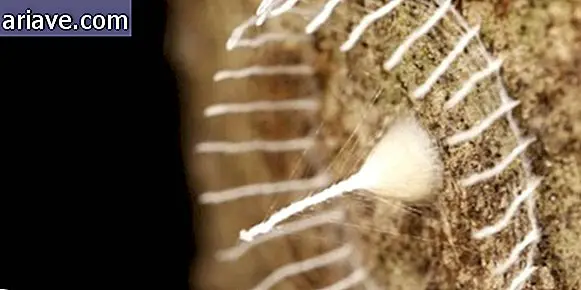Meet 7 of the most amazing extinct animals ever
Nature is full of species that science still does not know. On the other hand, there are also many plants and animals that have already occupied the planet but have ceased to exist over the years. Today we only have traces - such as fossils, footprints, accounts, and illustrations - to cure our curiosity and our thirst for knowledge.
Unfortunately, human activities and hunting are the factors that most contributed to the disappearance of animals that, if they lived today, would look like mythological beings because of their impressive size or unusual appearance.
Check out a little more about the history of each of these amazing animals that, unfortunately, we will never have the opportunity to see walking on Earth. And be sure to register your comment at the end of the article!
1) Quagga

Extinct since: 1883
Quaggas ( Equus quagga ) were originally classified as an individual species in 1788. It was only after the extinction of the animal that DNA scans revealed that it was a subspecies of zebra. The confusion came about because of the difference in color and distribution of stripes that are characteristic of these animals.
Unlike zebras, quaggas - which were numerous in the Cape and Orange region of South Africa - have traditional stripes only on the front of the body, while the back predominates a brown coat. The name of the animal is believed to come from the language spoken by the Khoikhoi, an ethnic group from southern Africa.
The search for the meat of the animal for food was one of the aspects that contributed to its extinction. It is estimated that the last animal was hunted in the late 1870s and the last captive bred is known to have died on August 12, 1883 at the Artis Magistra zoo in Amsterdam, the Netherlands.
2) Tasmanian Tiger

Extinct since: 1936
Tilacin ( Thylacinus cynocephalus ) has been known to be the largest carnivorous marsupial of recent times. This animal - which is native to Australia and Papua New Guinea - is believed to have become extinct in the 20th century. Due to its striped coat on the back, the tilacino is also known as the Tasmanian tiger or Tasmanian wolf. .
Unfortunately, this animal was the last member of its genre to be extinct. Tilacin disappeared from the Australian continent hundreds of years before European colonization in the territory. However, the animal survived on the island of Tasmania alongside other native species, such as the famous Tasmanian demon.
Bounty hunting was the determining factor in the disappearance of this species, but other aspects also contributed, such as diseases, the introduction of dogs and the invasion of man in its habitat. Despite being officially considered an extinct animal, some say they have seen apparitions of these marsupials.
3) Steller's Dugong

Extinct since: 1768
Originally found on the Asian coast of the Bering Sea, the steller dugong ( Hydrodamalis gigas ) is a mammal that was discovered in 1741 by naturalist Georg Steller. According to the expert's observations, the animal grew up to eight meters and could weigh up to three tons.
Its appearance resembled a giant seal, but the animal had two strong hind limbs and a whale-like tail. According to Steller, “The animal never comes to shore, but always lives in the water. Its skin is dark and thick, like the bark of an old oak tree ... Its head is small compared to its body ... The animal has no teeth but only two flat bones - one above and one below. The expert also points out that mammals were tame.
Fossils indicate that the steller dugong lived in the northern coastal region of the Pacific Ocean, reaching southern Japan and California. As the dugong population was rapidly decimated, human occupation in the region must have been the main cause of extinction. There are sporadic records of the appearance of these mammals in Bering and Greenland, suggesting that some Steller's dugongs may have survived, but there is no evidence to support this.
4) Giant Moose

Extinct since: about 5, 700 a. Ç.
The giant elk ( Megaloceros ) - also called the Irish moose - is the largest deer that has ever passed the earth. This animal lived in Eurasia from Ireland to the east of Lake Baikal in Russia during the late Pleistocene and early Holocene in the Cenozoic Era. The last traces of this species went through a carbon dating that pointed out that the material was of 5, 700 a. Ç.
The giant elk, as its name implies, impressed by its immense proportions. The animal measured about two meters from the ground to the shoulder blades and its antler could reach up to 3.65 meters from one end to the other, weighing about 40 kilos.
Discussions about the reasons that led the mammal to extinction focus on the animal's antler rather than its oversized size. So, as with many other animals on this list, human hunting was a determining factor in the disappearance of the species.
5) Auroch

Extinct since: 1627
One of the most famous extinct animals in Europe, the aurochs ( Bos primigenius ) are a much larger type of cattle than we know today. These animals developed in India two million years ago and migrated to the Middle East, Asia and reached Europe about 250, 000 years ago. In the 13th century, the remaining aurochs were concentrated in the region encompassing Poland, Lithuania, Moldova, Transylvania, and eastern Prussia.
The hunting of these animals was restricted only to the nobles and their employees, but as the number of aurochs decreased, the court prevented the practice, and it was still necessary that hunting inspectors ensure pasture and safety for cattle. Anyone caught breaking into animal areas could even be punished with death. In 1564, records pointed to the existence of only 38 aurochs. The last specimen of the species was a female who died in 1627 in the Jaktorów forest in Poland.
In the 1920s, two German zoologists decided to try to recreate the animal from their descendants. The result of the Heinz and Lutz Heck experiment was a breed that became known as “Heck cattle”, “recreated aurochs” or “Heck aurochs”, and bore some resemblance to wildlife.
6) Cave Lion

Extinct since: 1st century
The cave lion ( Panthera leo spelaea ) - also known as the European lion - is an extinct subspecies that has come to our attention through fossils and a wide variety of prehistoric art.
This subspecies represented one of the largest lions ever reported. An adult male discovered in 1985 in Germany had a height of 1.2 meters from the ground to the shoulder blades and a length of 2.1 meters without the tail. These measurements correspond to a large modern lion, although it is believed that this specimen was not one of the largest cave lions to be found.
In general, it is estimated that the subspecies was between 5% and 10% larger than the lions we know today. It seems that they were extinct about 10, 000 years ago during the last ice age (Ice Age). However, there is evidence that they recently existed until 2, 000 years ago in the Balkan region of Europe.
7) Dodo

Extinct since: late 17th century
With a funny name, the dodo ( Raphus cucullatus ) was a native bird of Mauritius. Although not flying, it has a direct relationship with the pigeons. Fossils revealed that the bird was about one meter tall and it seems that it was eating fruit and sheltering in the ground.
The first records of the dodo were made by Dutch sailors in 1598. From that time on, hunting by humans and their domesticated animals and the invasion of other species contributed to the extinction of the dodo. The species is considered extinct since the second half of the 17th century.
Interestingly, the only records of the animal's appearance in life came to us from illustrations, paintings, and accounts made in the 17th century. And, as these representations vary greatly, we have no way of knowing exactly what the dodo's true appearance was like.
* Posted on 28/05/2014
***
Did you know that Curious Mega is also on Instagram? Click here to follow us and stay on top of exclusive curiosities!











